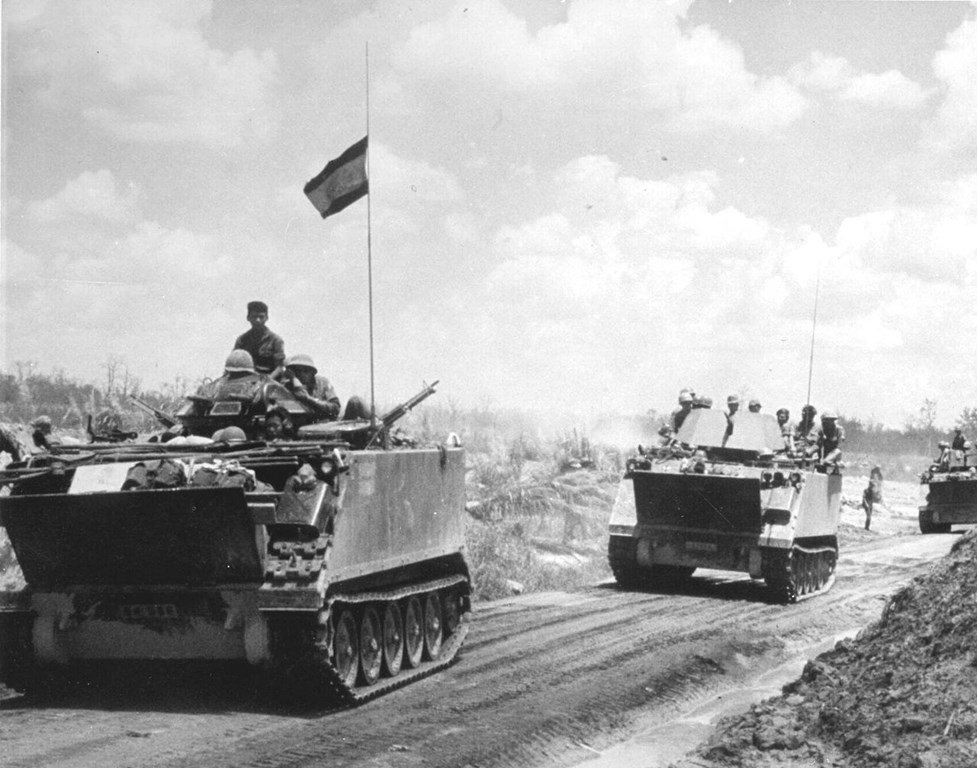Nixon Authorizes the Cambodian Incursion
April 28, 1970

President Nixon authorizes approximately 48,000 South Vietnamese Army and 32,000 U.S. Army Soldiers, supported by the U.S. Air Force, to cross the border from III Corps into Cambodia the next day. Their mission is to attack Viet Cong and North Vietnamese bases in Cambodia, which Communist forces have been using as a sanctuary from allied troops.
The incursion is the largest military operation of the war since 1967. By late June, the allies inflict over 11,000 enemy casualties and seize thousands of tons of military supplies and food. Nearly 1,000 allied troops are killed, including 338 Americans. North Vietnamese forces later reoccupy much of eastern Cambodia, and the incursion inflames antiwar sentiment in the United States.1
President Nixon’s decision to attack Communist sanctuaries in Cambodia proved to be one of the most controversial decisions of the Vietnam War. After the war ended, Nixon asserted that the incursion was “the most successful military operation of the Vietnam War,” but his contemporaries and many later historians have not shared this opinion. The bombings and ground operations in Cambodia prompted massive antiwar protests in the United States, the most well-known of which were the shootings at Kent State University, where National Guardsmen killed several demonstrators. Historians critical of Nixon’s wartime strategies have argued that the incursion into Cambodia failed to accomplish its primary objective: locate and eliminate the North Vietnamese Central Office for South Vietnam (COSVN), the planning and operations headquarters of the Viet Cong. The North Vietnamese had no trouble replacing the armaments and supplies destroyed by the Americans in Cambodia, and the Communist leadership was not impressed with this expression of Nixon’s “Madman Strategy,” which broke from President Johnson’s more conciliatory posture by threatening to escalate the war in unpredictable ways in order to convince Hanoi to accept Nixon’s peace terms. Some historians argue that the invasion inspired many Cambodians to side with the Communists and that a common enemy prompted the Khmer Rouge and the Vietnamese Communists, two groups that previously fought one another in Cambodia, to become allies. Ultimately, these historians suggest that Nixon’s Cambodian incursion did nothing to bring a hasty end to the Vietnam War on America’s terms and instead further destabilized Cambodia, contributing to the violent revolution that eventually claimed over one million lives.
A different group of historians counter these arguments and maintain that the Cambodian incursion has been unreasonably held up as symbolic of all the problems of the Vietnam War. They note, for instance, that members of the Joint Chiefs of Staff had petitioned the White House for permission to attack Viet Cong bases in Cambodia since 1964. Nixon’s mistakes, these scholars contend, were that he waited until 1970 to invade Cambodia, set restrictions arbitrarily preventing American troops from moving more than 30 kilometers inside Cambodia, and preemptively limited the duration of the campaign to two months. By announcing to the press that the United States’ incursion into Cambodia would be restrained, scholars say, Nixon encouraged the Viet Cong to temporarily retreat from the area, thereby limiting the campaign’s effectiveness. Still, these writers argue that Nixon’s greater emphasis on eliminating Cambodian sanctuaries and supply routes, coupled with his drive to strengthen the South Vietnamese armed forces, strangled the Communist insurgency in South Vietnam and helped ensure that North Vietnam’s large-scale Easter Offensive of 1972 failed. Thus, these historians uphold Nixon’s decision as strategically sound and successful in the sense that it contributed to an “honorable peace” in early 1973. The incursion was more a political failure than a military one, these scholars suggest, because of the escalated antiwar sentiment it engendered and because it served as a reason for Nixon’s political opponents in Congress to decline to send military aid to South Vietnam in 1975, the year Communist military groups overran South Vietnam and Cambodia.
Kimball, Jeffrey. Nixon’s Vietnam War. Lawrence: University Press of Kansas, 1998.
Chandler, David P. The Tragedy of Cambodian History: Politics, War, and Revolution Since 1945. New Haven: Yale University Press 1991.
Hess, Gary R. Vietnam: Explaining America’s Lost War. Malden, MA: Blackwell Publishing, 2009.
Shaw, John M. The Cambodian Campaign: The 1970 Offensive and America’s Vietnam War. Lawrence: University Press of Kansas, 2005.
Sorley, Lewis. A Better War: The Unexamined Victories and Final Tragedies of America’s Last Years in Vietnam. San Diego: Harvest Books, 1999.
Summers, Harry G. On Strategy: A Critical Analysis of the Vietnam War. Novato, CA: Presidio Press, 1982.
Willbanks, James H. Abandoning Vietnam: How America Left and South Vietnam Lost Its War. Lawrence: University Press of Kansas, 2004.